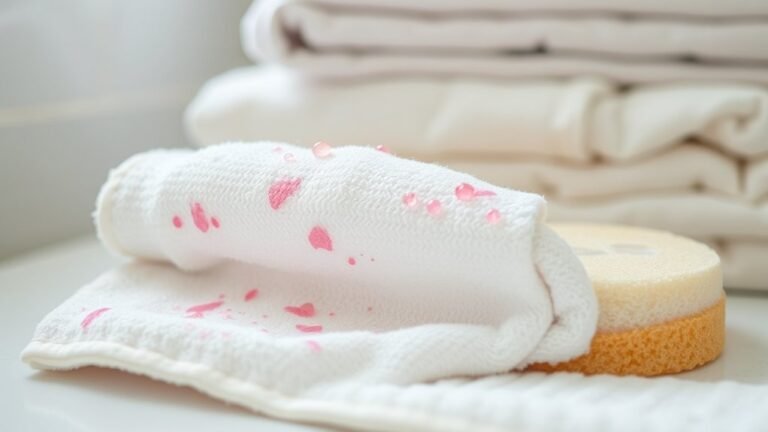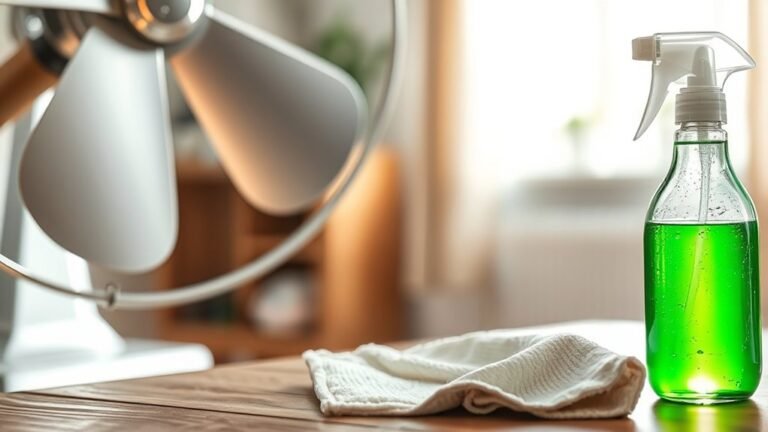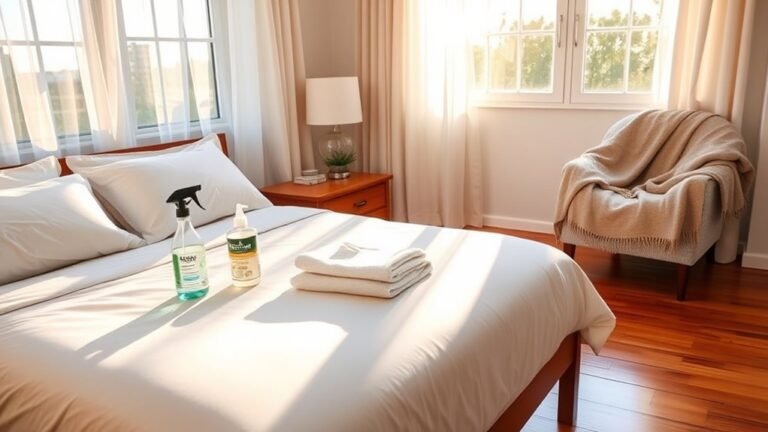Disinfecting High-Touch Areas in Living Room
When disinfecting high-touch areas in your living room, focus on doorknobs, remote controls, light switches, and tabletops. Choose disinfectants safe for each surface type, like gentle sprays for electronics and fabric-safe products for upholstery. Always clear and clean surfaces first to help disinfectants work better. Set a regular routine to keep germs in check and encourage hand washing to minimize spread. You’ll find more tips on effective cleaning techniques and scheduling as you keep going.
Identifying Common High-Touch Surfaces

Although you might not always notice them, high-touch surfaces in your living room are the spots you interact with most often throughout the day. These high touch items include doorknobs, remote controls, light switches, tabletops, and armrests. Each of these surfaces carries a unique combination of materials—wood, plastic, metal, or fabric—that can affect how germs linger and spread. Understanding the surface materials helps you target your cleaning efforts more effectively, ensuring you maintain a space that supports your freedom to relax and connect without worry. By identifying these key touchpoints, you take control of your environment, making it easier to keep your living room safe and inviting for yourself and anyone you welcome inside.
Choosing the Right Disinfectant Products
When selecting disinfectant products, you’ll want to contemplate the types of surfaces in your living room and the specific germs you’re targeting. Not all disinfectants work well on every surface, so picking the right one guarantees efficiency without damage. You might prefer natural alternatives like vinegar or hydrogen peroxide, which offer safe, eco-friendly options while still tackling many common microbes. However, it’s essential to check the product’s label for its effective concentration—this assures it’s strong enough to kill germs but not so harsh it harms your furniture or skin. Balancing potency with safety lets you maintain a clean, healthy living space on your own terms, without relying on harsh chemicals or complicated routines.
Preparing Surfaces for Effective Cleaning

Before you start disinfecting, it’s important to clear and prepare the surfaces properly to guarantee the disinfectant works effectively. Surface preparation sets the stage for a thorough clean, so remove clutter, dust, and any visible dirt first. Grab your essential cleaning tools—like microfiber cloths, brushes, and a gentle detergent—to tackle grime without damaging surfaces. Wiping down with these tools loosens debris, allowing disinfectants to reach and kill germs more efficiently. Don’t skip this step; a clean surface means your disinfectant won’t get blocked by dirt, maximizing its power. Taking a few extra minutes to prepare surfaces gives you the freedom to enjoy a truly sanitized living room, where high-touch areas are genuinely clean and safe for you and your loved ones.
Step-by-Step Guide to Disinfecting Doorknobs
Start by grabbing a disinfectant that’s effective against viruses and bacteria, and a clean microfiber cloth. First, identify your doorknob materials—whether metal, plastic, or wood—because this affects which disinfectant you should use to maintain disinfectant effectiveness without damaging the surface. Spray or apply the disinfectant directly onto the doorknob, ensuring full coverage. Let it sit for the recommended contact time to maximize germ-killing power. Then, wipe thoroughly with the microfiber cloth, paying close attention to crevices and around the base where germs hide. Repeat this process regularly to keep freedom from germs, ensuring your living space stays safe without restricting your lifestyle. Remember, the right disinfectant and method empower you to protect your home effectively.
Proper Techniques for Cleaning Remote Controls

When cleaning your remote controls, picking the right cleaning products is key to avoid damage. You’ll want to use disinfectants that are effective yet gentle on electronics. Next, follow a clear step-by-step process to guarantee every button and surface is properly sanitized.
Choosing Safe Cleaning Products
How can you guarantee your remote controls stay germ-free without damaging their sensitive components? Start by choosing safe cleaning products that respect both your health and the environment. Opt for eco friendly alternatives like diluted vinegar solutions or gentle plant-based sprays, which avoid harsh chemicals that might corrode buttons or screens. Prioritize chemical safety by steering clear of bleach, ammonia, or alcohol-based cleaners that can seep into crevices and cause damage. Using microfiber cloths dampened—not soaked—with these milder products lets you clean effectively without risking moisture buildup. This way, you maintain freedom from harmful substances while protecting your devices. Thoughtful product choices empower you to keep your living room safe and fresh without compromising the longevity of your remote controls or your well-being.
Step-by-Step Disinfection Process
Keeping your remote controls germ-free without harming their delicate parts means following a careful cleaning routine. You want effective disinfection techniques that respect your device’s sensitivity. Start by removing batteries, then wipe the surface with a microfiber cloth dampened with isopropyl alcohol. Avoid soaking or spraying directly. Stick to a consistent cleaning schedule—ideally weekly—to keep germs at bay and maintain freedom from worry.
| Step | Action |
|---|---|
| 1 | Remove batteries |
| 2 | Use microfiber cloth with alcohol |
| 3 | Gently wipe all buttons and surface |
| 4 | Let dry completely before reassembling |
| 5 | Repeat weekly as part of cleaning schedules |
This process guarantees your remotes stay clean without damage.
Safely Disinfecting Light Switches and Outlets
When disinfecting light switches and outlets, you need to pick safe products that won’t damage electrical components. Make sure to use a damp cloth with disinfectant rather than spraying directly to avoid moisture buildup. Following proper cleaning steps keeps these high-touch spots germ-free without risking safety.
Choosing Safe Disinfectants
Although it might seem straightforward, choosing the right disinfectant for light switches and outlets requires care since these surfaces can be sensitive to harsh chemicals. You want to protect your living space without compromising the integrity of these fixtures. Opt for eco friendly options that are gentle yet effective. These products reduce chemical exposure, supporting your freedom to maintain a healthy home without harsh toxins. Always check labels for chemical safety, avoiding bleach or abrasive ingredients that can damage plastic or metal components. Instead, consider disinfectants with natural active ingredients like hydrogen peroxide or alcohol in safe concentrations. By selecting safe disinfectants, you not only keep your high-touch areas clean but also uphold your commitment to a safer, healthier environment for you and your loved ones.
Proper Cleaning Techniques
Selecting the right disinfectant is just the first step; knowing how to apply it correctly on light switches and outlets makes all the difference in keeping these surfaces truly clean and safe. Don’t fall for common cleaning myths, like soaking switches or spraying directly—both can cause damage or ineffective surface sanitization. Instead, lightly dampen a cloth with disinfectant and gently wipe the surfaces.
| Step | Action |
|---|---|
| 1. Preparation | Turn off power to avoid shocks |
| 2. Application | Use a damp cloth, not spray |
| 3. Drying | Let air dry completely |
Following these steps guarantees your living room is free from germs without risking device damage, giving you the freedom to enjoy a safe, sanitized space.
Maintaining Clean Tabletops and Coffee Tables
Keeping your tabletops and coffee tables clean is key to reducing germs in your living room. To maintain these surfaces, choose cleaning techniques that suit your tabletop materials—whether wood, glass, or metal. For wooden tables, use a damp cloth with mild soap to avoid damaging the finish, then dry immediately. Glass tabletops respond well to vinegar-based sprays or commercial glass cleaners, leaving them streak-free. Metal surfaces can be wiped with disinfectant wipes or a solution of water and rubbing alcohol. Regularly removing dust and spills prevents grime buildup, making disinfection more effective. By tailoring your cleaning approach to the material, you keep your living space fresh and germ-free without sacrificing the freedom to enjoy your home’s unique style.
Tips for Disinfecting Upholstered Furniture
Upholstered furniture often collects dust, allergens, and germs more quickly than you might expect, so it’s important to disinfect these surfaces regularly. When doing upholstery cleaning, always check fabric care instructions to avoid damage. Use a fabric-safe disinfectant spray that won’t bleach or stain. For a deep clean, vacuum your furniture first to remove dirt and debris.
Here’s a quick guide to keep your upholstery fresh and germ-free:
| Step | Tip |
|---|---|
| Vacuum | Remove loose dirt and allergens |
| Spot Test | Test disinfectant on hidden area |
| Fabric-Safe Spray | Use products made for upholstery |
Scheduling Regular Disinfection Routines
You’ll want to set consistent times each week to disinfect your living room. Focus especially on high-traffic surfaces that get touched often. Sticking to a routine helps keep germs at bay and your space healthier.
Establish Consistent Cleaning Times
Regularly scheduling your cleaning sessions makes it easier to stay on top of disinfecting high-touch areas in your living room. By setting consistent cleaning times, you create a reliable rhythm that fits your lifestyle without feeling restrictive. Decide on a cleaning frequency that suits your pace—whether it’s daily, every few days, or weekly—and stick to it. Using routine reminders on your phone or calendar helps you avoid forgetting and keeps the task from piling up. When cleaning becomes a steady habit, it won’t feel like a chore but a natural part of your freedom to enjoy a fresh, safe space. Establishing these consistent times guarantees your living room stays inviting with minimal effort on your part.
Prioritize High-Traffic Surfaces
Since some areas in your living room get touched more often than others, it makes sense to focus your disinfecting efforts there first. High traffic areas like doorknobs, remote controls, and coffee tables face constant contact, so prioritizing them saves you time and keeps your space healthier. Pay attention to the surface materials too—glass, wood, or plastic each require different cleaning approaches to avoid damage. Scheduling regular disinfection routines around these spots guarantees you maintain a clean environment without feeling overwhelmed. By targeting where germs accumulate most, you gain control over your living space and protect your freedom to relax worry-free. Remember, smart prioritization means less fuss and more peace of mind in your living room.
Preventive Measures to Minimize Germ Spread
Although disinfecting is essential, taking preventive measures can greatly reduce the spread of germs in your living room. To cut down on germ transmission, you should encourage everyone to wash their hands regularly and avoid touching their faces. Keeping your space well-ventilated also helps minimize airborne germs. Adjust your cleaning frequency based on how often the room is used; more frequent cleaning means fewer germs lingering on surfaces. You might also consider using washable slipcovers or easily cleaned materials on furniture, making maintenance simpler. By combining these habits with regular disinfection, you’ll create a safer environment without feeling restricted. Taking control of these small actions lets you enjoy your living room freely while keeping it healthier for everyone around you.
Frequently Asked Questions
Can Disinfectants Damage Electronic Devices in the Living Room?
Imagine your favorite gadget as a delicate butterfly; using harsh disinfectant types is like trying to clean it with a storm, risking damage. You don’t want to sacrifice electronic safety while keeping things clean. So, you should opt for gentle, device-friendly disinfectants like alcohol wipes with 70% isopropyl alcohol. This way, you protect your freedom to use your devices without worry, balancing cleanliness and care effortlessly.
How Long Should a Disinfectant Remain on Surfaces to Be Effective?
You’ll want to pay close attention to the disinfectant contact time to make sure it’s effective. Different products require different amounts of time to kill germs, usually ranging from 30 seconds to 10 minutes. Also, surface material impacts how long the disinfectant should stay wet—porous surfaces might need longer contact times than smooth ones. Always follow the label instructions so you’re not left guessing and can keep things safe and clean.
Are Natural Disinfectants as Effective as Chemical Ones for High-Touch Areas?
Did you know that some natural alternatives can reduce bacteria by up to 99.9%? When you compare disinfectants, chemical ones often act faster and cover a broader range of germs. However, natural options like vinegar or essential oils can be effective if used properly. If you value freedom from harsh chemicals, you might prefer natural disinfectants, but keep in mind they may require longer contact time and more frequent application for the best results.
How Do Humidity and Temperature Affect Disinfectant Effectiveness?
You’ll find that humidity levels and temperature fluctuations can really impact how well disinfectants work. High humidity might slow drying times, making some disinfectants less effective, while low humidity could cause them to evaporate too quickly. Temperature swings also play a role—extreme heat or cold can reduce a disinfectant’s potency. So, if you want freedom from germs, keeping a stable environment helps your disinfectant do its best job.
Can Frequent Disinfection Cause Allergies or Skin Irritation?
Yes, frequent disinfection can sometimes trigger allergy symptoms or increase skin sensitivity, especially if you’re using strong chemicals regularly. Your skin might get irritated or dry, and you could experience sneezing, itching, or watery eyes. To stay free from discomfort, try using gentle disinfectants, wear gloves, and guarantee good ventilation while cleaning. Listening to your body helps you maintain both cleanliness and your well-being without feeling restricted.






